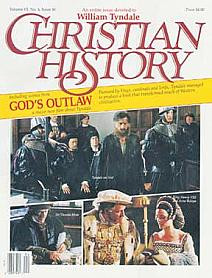William Tyndale Published Obedience of a Christian Man
EDUCATED AT OXFORD AND CAMBRIDGE, William Tyndale became a tutor for the children of Sir John Walsh at little Sudbury Manor. Walsh often entertained the local clergy at his table. Sitting with them, the scholarly Tyndale was appalled at the lack of knowledge the clergy had of the Scriptures. In one heated exchange with a clergyman, he exclaimed, “If God spare my life, ere many years pass, I will cause a boy that driveth the plough shall know more of the Scriptures than thou dost.”
Tyndale requested authorization to translate and print the Bible in English. When this was denied him, he left England as a fugitive in 1524 and made the translation on the European mainland. Soon he issued the New Testament, but it was banned and burned by English bishops. England’s religious and political leaders launched a propaganda war against him. Tyndale replied by publishing pamphlets.
King Henry VIII asked Sir Thomas More to refute Tyndale. More accused Tyndale of preaching sedition (treason against the king). On this day, 2 October 1528, Tyndale responded with The Obedience of a Christian Man, a pamphlet arguing that a good Christian obeys the king in so far as the king obeys God. He supported his points from the Bible, declared that Scripture is the Christian’s final authority in matters of faith, and attacked teachings such as salvation by works.
In response to objections to translating the Bible into English, Tyndale answered, “They say our tongue is too rude. It is not so. Greek and Hebrew go more easily into English than into Latin. Has not God made the English tongue as well as others? They [allow] you to read in English of Robin Hood, Bevis of Hampton, Hercules, Troilus, and a thousand ribald or filthy tales. It is only the Scripture that is forbidden. It is therefore clearer than the sun that this forbiddal [forbidding] is not for love of your souls, which they care for as the fox doth for the geese.”
Although it had to be smuggled into England, Tyndale’s New Testament was a bestseller. The king’s agents searched Europe for him, forcing Tyndale to stay on the move. Finally, he settled with some friendly merchants in Antwerp (now in Belgium, but then part of the Duchy of Brabant within the Habsburg Netherlands), where he continued translating. He had completed about two thirds of the Old Testament before he was betrayed into the hands of Belgian Catholics who strangled and burned him in 1536. His last prayer was “Lord, open the King of England’s eyes.” Just three years later, in 1539, Tyndale’s prayer was partially answered when Henry VIII required every parish church in England to provide a copy of the Bible in English. The translation selected was largely based on the work of William Tyndale.
—Dan Graves
------------
For more, consult Christian History #16, William Tyndale: God's Outlaw
or watch God's Outlaw, the Story of William Tyndale at RedeemTV
God's Outlaw can be purchased at Vision Video







